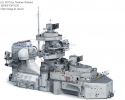GERMAN WURZBURG TYPE A RADAR(“SMALL WURZBURG”)
Radar used by German anti-aircraft defences in the Second World War
During the 1930s both Britain and Germany were developing radar – or radio direction finding (RDF) as it was originally called. When Telefunken’s Wurzburg Type A was first demonstrated in July 1939 it was accurate to within 100 meters and half a degree at a range of 18 miles (30 km).
About 4,000 were in service during the war for anti-aircraft gun laying and ground controlled interception of Allied bombers by German fighters. The latter role became less important after 1942 when the longer-range Giant Wurzburg appeared, an example of wich can be seen at the Museum’s site at Duxford Airfield.
The discovery, by photographic reconnaissance, of a Wurzburg site at Bruneval on the French coast led to one of the most daring British special operations of the Second World War. On the night of 27-28 February 1942, 119 men parachuted into France and not only retrieved the main components of the Wurzburg but also returned with one of its operators.
This example of the small Wurzburg was brought to Britain after the Second World War for evaluation and was subsequently aquired by Martin Ryle (later Professor Sir Martin Ryle FRS), the Cambridge astronomer, who bequeathed it to the Museum.
Technical specifications:
CREW: Four
RANGE:
Search mode: 19 to 25 miles (31 to 40km)
Direction finding: 11 miles (17.7km)
DIMENSIONS:
Height: 13ft 10in (4.2m)
Width: 17ft 11in (5.5m)
WEIGHT: 3,900lb (1,769kg)








